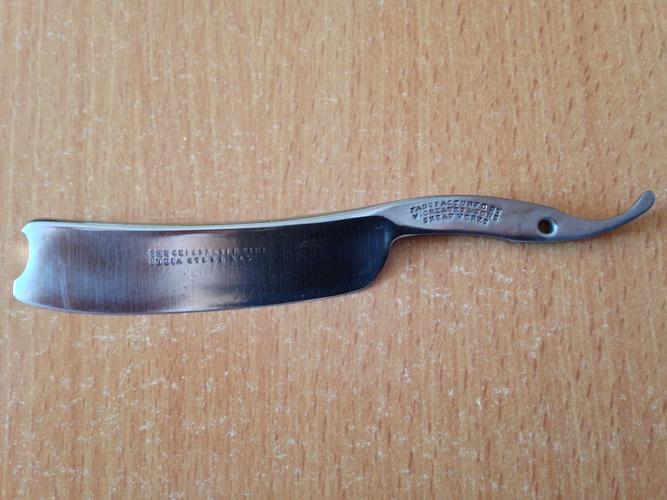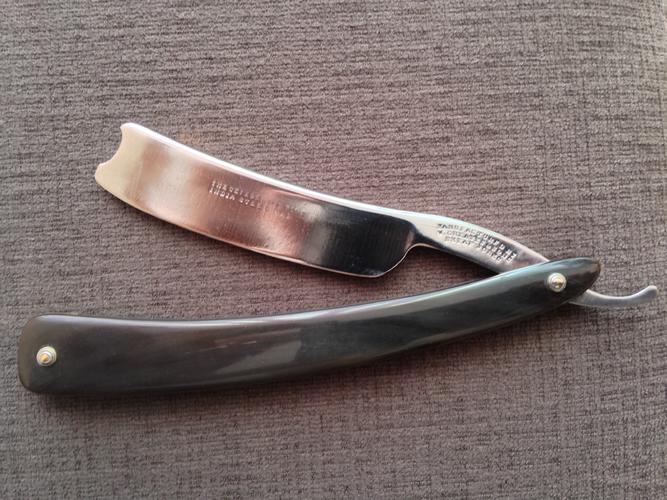Results 1 to 10 of 31
Thread: Tired of easy polishing
-
07-05-2016, 10:09 AM #1
 Tired of easy polishing
Tired of easy polishing
hi guys,
i recently had some old blades (razor blades) to restore them. they are waiting now for a long time. the problem is i don't want to start without a decision how to clean them as new.
here the facts about blades; they have black marks, nothing unsual. i can handle this.
but there are also some deepper stains after cleaned up the rust which i don't know really how to go on. there is advanced handsanding thread, i read it, and also give a try but really it doesn't work if i had a polishing machine (big wheels and a powerfull motor).
i've for now only a dremel, with some sanding wheels (i don't like to use to on blade, it leaves blank marks), and cloath and whool wheels.
so i'm looking for a result like this;


so i know there are some greaseless pastes but do you think i can use them with a dremel?
also to have a clean finishing, did you ever thought to go further then "3 (power level)" ?
-
07-05-2016, 10:38 AM #2Senior Member

- Join Date
- Aug 2015
- Posts
- 317
Thanked: 15
Pics of your blades? I've had disastrous results with power tools of late so I can recomend hand sanding 100%. It is time consuming and hard on the fingers but that's the safest way to get the results you'll be happy with. Spend the most time on the lowest grits. Make sure you are happy with it removing everything from pits to stains then move on.
The problem with power tools is things go bad in a hurry. There is no way of putting metal back on. The other problem is wheel diameter, Imo unless you have the right wheel diameter for your razor the results can be blotchy.
As a direct answer to your question. Yes, there are polishing pastes out there that might be enough. Yes, they will work with a dremmel. I don't think there are many here who will recommend it. I'm sure you'll get responses from the pros soon, but that's my two cents worth.
Sent from my SCH-I435 using Tapatalk
-
07-05-2016, 12:44 PM #3

You know even in the hands of pros, still the hand work will pay off in the end, too many new guys just remove too much steel, round the crisp edges off, take the et hing down, etc. etc. it doesn't take that long, Tc
“ I,m getting the impression that everyone thinks I have TIME to fix their bikes”
-
07-05-2016, 01:29 PM #4Senior Member



- Join Date
- Apr 2012
- Location
- Diamond Bar, CA
- Posts
- 6,553
Thanked: 3215
Most any defect on the blade can be removed by hand sanding, but will take some work and the proper grites. What grits are you using.
Even then, sometimes you have to decide if you want to leave some pitting or remove too much metal.
Greaseless polishing is an alternative, but is aggressive,can be dangerous and will require a bench buffer. I have tried it with a Dremel and have not had good results, as the wheel contact area is too small and can make for a wavy blade.
Some photos of the problem areas of you blade and a change in hand sanding techniques might be a better and safer.
-
07-05-2016, 03:22 PM #5Senior Member




- Join Date
- Feb 2013
- Location
- Haida Gwaii, British Columbia, Canada
- Posts
- 14,450
Thanked: 4829
I have a bench buffer. It sees very little use. I do all the heavy work by hand with sandpaper and a hard backer. Most of the time my backer of choice is wine corks. I also use WD-40 to keep the scratch patterns a little more shallow and even. I rarely go below 600 paper and often spend a lot of time at 1000. I have used the Dremel with polish and greaseless compound and have to say it has it's applications, but sees very little use. I always try to preserve the lines of the razor as well as I can and the greatest control is with careful hand sanding.
It's not what you know, it's who you take fishing!
-
The Following User Says Thank You to RezDog For This Useful Post:
ScoutHikerDad (08-13-2016)
-
07-05-2016, 04:16 PM #6

no they are not mines but of a friend.
while handsanding, i start from 400 if it goes well, i continue untill 2000 then dremel. otherwise, i if there is too much rust or deep marks i go back 240, 180 (at least) then come back untill 2000. but here is the problem, when there is deep marks on the blade, even with advanced handsanding methods don't work.
i tried to find some of my works to give an exemple but the are deleted due a problem with my old pc.
-
07-05-2016, 04:54 PM #7Senior Member



- Join Date
- Apr 2012
- Location
- Diamond Bar, CA
- Posts
- 6,553
Thanked: 3215
Greaseless and a buffer will remove steel much quicker, but that is the problem, in un-skilled hands, (and there is a big learning curve) that can quickly remove detail.
If you do decide to experiment with greaseless, practice on a beater to learn just how fast metal will be removed. A Greaseless buffer is truly a double edge sword.
Restoration, begins at purchase.
-
07-05-2016, 04:59 PM #8I used Nakayamas for my house



- Join Date
- Aug 2009
- Location
- Des Moines
- Posts
- 8,664
- Blog Entries
- 1
Thanked: 2591
Deep pitting can be removed , most of the time, with a buffer. Sometimes pitting will be left behind, because you would not want to round the lines off.
Basically the razor tells you how much you can remove and that is it, sometimes we have to live with imperfections. Heavier grinds can be reground with a grinder but that is a big investment and requires a lot of skill to produce good results.Stefan
-
07-05-2016, 05:42 PM #9

I doubt greaseless on a dremel will be efficient. It will work, but you're going to have to re-apply it an awful lot of times I think.
Til shade is gone, til water is gone, Into the shadow with teeth bared, screaming defiance with the last breath.
To spit in Sightblinder’s eye on the Last Day
-
07-05-2016, 06:02 PM #10

A carded buffing head mounted in a drill press or even a drill can make a quick cheap alternative to a buffer.


 61Likes
61Likes LinkBack URL
LinkBack URL About LinkBacks
About LinkBacks






 Reply With Quote
Reply With Quote


